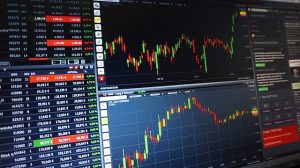Since the beginning of 2018, Australia’s major banks have been under pressure from a combination of factors, including rising loan defaults in the housing market and global economic downturns. Significant drops in investor sentiment have led to a significant drop in Australian lenders’ share prices, which is an opportunity for some traders.
The options available when trading bank stocks include ‘vertical spreads’, where a trader typically purchases one option and sells another of either higher or lower strike price. Credit spreads are the other option, where a trader typically sells iron condors (an option spread traded with four legs: long put at a lower strike, short call at a higher strike, a short put at the same (higher) strike and long call at the same (lower) strike).
Directional Exposure
Vertical spreads only give the trader directional exposure to the price action of the underlying share. In contrast, credit spreads provide a limited directional exposure and unlimited potential for leverage.
Maximum Gain
Vertical spreads generally have a more significant maximum gain than credit spreads and a limited loss. Credit spreads have a smaller maximum gain but can result in considerable losses when there is significant movement in the traded options’ price.
Time Until Expiration and Contract Size
Vertical spreads have the same expiration date and contract size, while you can trade credit spreads with different expiration dates or contract sizes. Vertical spread contracts are typically around $100,000 notional value, while credit spreads are $10–$20 per leg.
Margin Rates and Initial Margin Requirement
Vertical spreads require less margin than credit spreads and result in less leverage. When trading vertical spreads for bank stocks, margins range from 0–6%, while when trading Iron Condors for bank stocks, margins can reach up to 28%. The initial margin requirement for vertical spreads is around 10%, while credit spreads have 15%–18%.
Liquidity and Transaction Costs
Vertical spreads generally have greater liquidity than credit spreads, as there are far more market participants interested in buying the options being purchased. Vertical spread transactions also have lower transaction costs because they typically consist of traded contracts rather than four to five legs.
Probability of Profit and Time to Expiration
Due to their limited risk profile, vertical spread traders can aim for a much larger percentage return on investment when compared to credit spread traders. For example, if a trader expects a stock’s value to increase by 2%, they should expect a 10% return on their investment with vertical spreads if they are to be executed successfully. With credit spreads, the trader may only make around 2%–3% return on their investment if executed successfully.
The trade-off is that credit spread traders have a much shorter period to make a positive return on their investment because of its limited risk profile. Vertical spread traders can hold onto contracts for months before expiry. In contrast, credit spread traders do not have this flexibility as holding past expiration dates will result in an automatic assignment or exercise of the contract(s).
Expiration and Exercise
Vertical spreads expire with no value due to offsetting option positions. In contrast, both legs of a credit spread typically expire with a positive value and may be assigned (the short leg) or exercised (the long leg).
Open Interest
Open interest is typically much lower than credit spreads when trading vertical spreads, which means that fewer market participants are interested in executing transactions when entering into a trade. Vertical spreads have greater liquidity due to this phenomenon because traders will always have the ability to offset their contracts through an opposing trade if they so desire.
Credit spread trades have a greater open interest because each side of the transaction has more potential buyers/sellers. After all, it consists of only two legs rather than four. If traders wish to execute a credit spread using bank stocks, they can easily find counter-parties when placing their order(s). When trading credit spreads, you can find open interest in the OI forum provided by OIC. Open interest is the number of trading options contracts that have not yet been offset in the marketplace.
Open interest increases when two traders agree to trade with each other, but no one has completed the transaction as both traders are still holding onto their options.

